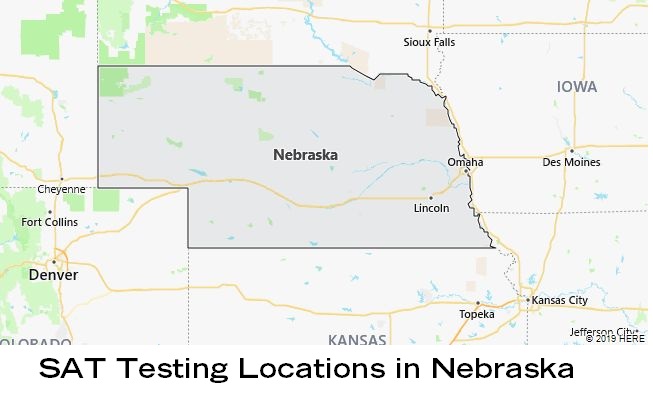According to the College Board, there are 3 test centers for SAT and SAT Subject Tests in Nebraska. Please note that before you register either of the SAT exams, you should choose your test date and test location. Each testing location is affiliated with an educational institution, such as high school, community college, or university. The following test centers administer one or more of SAT tests in Nebraska.

2019 – 2020 SAT Test Dates in Nebraska
- March 9, 2019
- May 4, 2019
- June 1, 2019
- August 24, 2019
- October 5, 2019
- November 2, 2019
- December 7, 2019
- March 14, 2020
- May 2, 2020
- June 6, 2020
- August 29, 2020
- October 3, 2020
- November 7, 2020
- December 5, 2020
SAT Testing Centers in Nebraska
GRAND ISLAND SR HS
RALSTON HS
WESTSIDE HS

Nebraska State Overview
In 1762, after the defeat of France in the Seven Years’ War, her colonies in North America, located on the right bank of the Mississippi River (including Nebraska), went to Spain. In 1800, France regained control of Louisiana, and in 1803 sold it to the United States of America. At the end of the 18th century, several trading posts were founded in Nebraska.
The United States explored its new lands, in 1804 the famous expedition of Meriwether Lewis and William Clark crossed Nebraska, heading for the Pacific coast. In 1806, an expedition led by Zebulon Pike passed through the southern regions of the state west to the Rocky Mountains.
In 1812, the Nebraska lands became part of the newly formed Missouri Territory. In the same year, the Fort Lisa trading post, the first American settlement in Nebraska, was founded in the area of the modern city of Omaha. In 1819, Fort Atkinson was built in Nebraska, the first outpost of the US Army west of the Missouri River.
In the early 40s of the 19th century, the Oregon Trail ran through Nebraska, along which thousands of settlers rushed west.
In 1854, the Nebraska Territory was created, which partially included, in addition to Nebraska proper, the lands of the modern states of Colorado, Wyoming, Montana, South Dakota and North Dakota. Omaha became the capital of the new territory.
After the adoption in 1862 of the “Law on Land Allotments” (“The Homestead Act”), which made it possible to easily obtain land, the number of immigrants increased sharply (from 1860 to 1870, the population of Nebraska more than quadrupled). Population growth also strengthened the desire for statehood, on March 1, 1867, the US Congress decided to recognize Nebraska as the thirty-seventh state of the United States.
Now in the state’s largest city, Omaha, about 480,000 people live (and in the urban agglomeration of Omaha – about 950,000 people). Nebraska’s capital, Lincoln, has about 290,000 residents.
The economy of Nebraska is based primarily on agriculture. The “corn cob state” is part of the ” grain belt “, corn, wheat, sorghum, soybeans, sugar beets and other crops are grown here. Animal husbandry is very well developed in Nebraska, primarily cattle breeding. The industry of the state is, first of all, food processing and biofuel production. Bailey Yard, the largest railroad station in the United States (and the world), is located in Nebraska.
